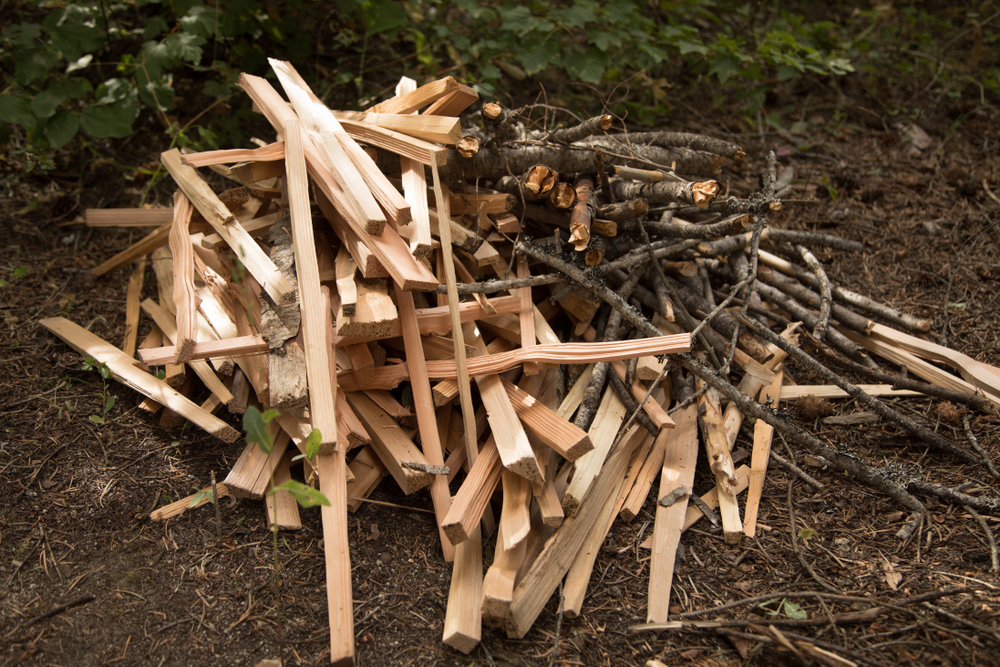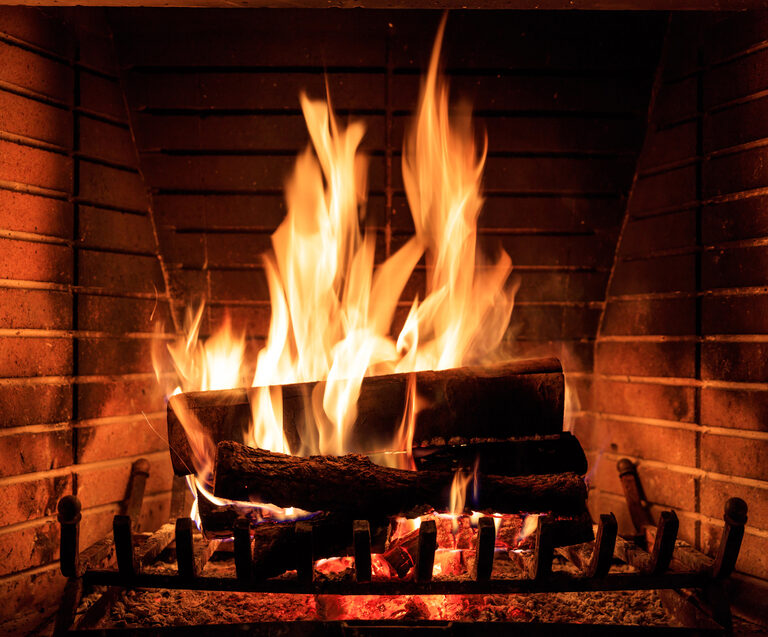If you’ve ever sat next to a lit fireplace on a cold winter day, you know it’s one of the best things ever. It’s cozy, comfy, relaxing, and the warmth envelops you in a hug that feels like no other.
You probably got really excited when you moved into your new house or apartment with a fireplace that can still function, and that excitement probably died down when you realized you had no idea how to get it started. But don’t worry, we’ll teach you how to safely start a fire in a fireplace.
Supplies You Need
Before we get started, let’s go over the materials you need to gather.
Safety Matches or a Long-Reach Lighter
You’ll want to get extra-long wooden matches or a long-reach, butane-refillable lighter. These will give you enough room to stand back so you’re not too close to your kindling and risk getting burned.
It doesn’t have to be fancy, but if you’re going to use matches, make sure the stem is sturdy so they don’t break off when you strike them.
Kindling

Although the use of gas in lighting fires is a popular choice in movies, it’s a big no-no. The Environmental Protection Agency (EPA) strongly recommends against using flammable liquids like alcohol in starting your fire.
Instead, look for dry wood and twigs. Make sure they’re not overly large or too small. Small pieces that fit perfectly in your fireplace with at least a few inches of clearance all around should be good enough.
Sheets of Newspaper
Matte, uncoated sheets of newspaper are perfect to use as a tinder for your fireplace. Make sure you don’t use glossy ones or take them out of your garbage. These can be toxic when burned, not to mention they’ll make the space smell funky.
Seasoned Firewood
The EPA recommends using well-seasoned hardwood. They should be split correctly too for a safe flame.
Grate
A wrought iron fireplace grate will add safety to your fireplace. It will keep your logs and kindling from accidentally rolling out of your fireplace, as well as keep the fire inside.
Make sure you choose a design that allows for enough air to pass through underneath and around your logs.
Screen
In order to prevent accidental fires, the U.S. Fire Administration (USFA) recommends using a metal or glass screen to cover the entire width of your fireplace’s opening. This will help keep your fire contained as well as prevent any sparks or embers from escaping. It will also prevent unwanted material, and even children and pets, from going into the fireplace.
Utensils
Wrought iron pokers, tongs for handling firewood, a shovel, and a brush are some of the most important fireplace “tools” you need to keep at hand. You also need to look into getting an ash bucket with a metal lid so you have a safe place to store your ashes.
Fire Extinguisher
When dealing with any kind of fire at home, it only makes sense to have protective equipment ready, as well as a reliable fire extinguisher you can use in case things don’t go your way. Even if you don’t have a fireplace, it’s still important to keep a fire extinguisher in your home, and it’s even required to meet fire code if it’s an apartment unit.
What to Do Before Lighting a Fire
Now that you know what you need, it’s time to go over all the precautionary measures you need to take before you start a fire. You can start a mental checklist every time you start to light your fireplace, but make sure you don’t skip any of these steps for your safety.
Check the Fireplace Area
The area should be clean. There shouldn’t be any ashes left, and there shouldn’t be anything hanging off of the mantle that could catch fire. Clear your hearth and the area surrounding it first before loading it up with new firewood.
Check the Chimney
The chimney should be clear from any obstructions. Its protective liners need to be in good working order to ensure safety. If you’re not too sure, you could always get it checked out by a professional. And remember to ask a few questions to make sure they’re trustworthy.
Check Air Quality
If you suspect that there’s a gas leak anywhere in your home, do not attempt to light a fire, or you could end up lighting your entire house on fire. You also need to make sure your chimney and fireplace are well-ventilated to avoid any surprises.
How to Start a Fire in a Fireplace
It’s finally time for you to start the fire. Take it one step at a time and make sure you’re careful. You won’t be able to enjoy your fireplace as much if you burn your hands.
Step One: Prep Your Kindling
Start by placing two pieces of medium-sized firewood on your metal grate. They should be around six inches apart. Next, crumple a few sheets of newspaper and place them in between the two logs. This will act as your tinder.
Once you’ve got a good amount of tinder, cover it with kindling before proceeding to place about two more pieces of firewood on top of the first two. Check that there is enough space for air to pass through.
Step Two: Starting the Fire
Before you strike a match, it’s good practice to check your vent. The damper should be completely opened before you get a fire started. Now, take another sheet of newspaper and twist it up for more stability.
Hold it as high up as you can in the fireplace, and light the tip with your match or lighter. This will facilitate a good draft in your hearth. Take note that a sheet of newspaper tends to burn quickly so you need to stay calm and be careful to avoid any accidents. Next, light your kindling using the burning sheet of newspaper.
Step Three: Sustaining Your Fire
Once you have a fire going, make sure you check in once in a while to add firewood as necessary. The flames should also be visible below the fireplace opening.
If your flames start to get too large, you should stop adding firewood. One way to help reduce the size of the flames is by using your poker to move the logs around. Note that when the flames get too big, the entire room will get super hot real fast. You won’t have to worry about being cold, but you’re going to be hot and sweaty, and it won’t be comfortable.
Safety Reminders
Lighting a fire in your home must be done in a highly contained environment following the strictest safety protocols. After all, you never know when a small fire can lead to your entire living room catching fire.
Set Clearance
Households that have pets or small children should always make sure that they’re accompanied by adults and watched very carefully if you have a fire burning in the fireplace. It’s a good idea to set up a protective gate around your fireplace that has at least a three-foot clearance.
It may eat up a lot of your space, but this will prevent any harm from coming to your children or pets.
Remember to Clean Up
Do not leave a fire burning unattended in your home. Make sure you put it out before you head to bed or go someplace else. After all, you never know what could happen in the short time you leave it unattended.
Once you’ve put out the fire, there are a few things you need to do to make sure your fireplace is well-maintained.
Separate the Logs
Start with using your poker to move the firewood around so they’re separated from each other. They should end up scattered all around your fireplace.
Close the Doors
Once your ash and logs have cooled completely, it’s time to shut your damper. Make sure it’s closed off tightly so a draft can’t blow the ash around your living space.
Ash Disposal
Once the ash has completely cooled down, put it in a bucket. You could also scoop it out into a trash can using a shovel, but it would be better to have a designated container for ash. And remember to wet it so it doesn’t get anywhere with the slightest movement. Whatever you’re using to collect the ash should be kept outside of your home until it’s collected by the garbage people.
Final Reminders
Now that you know how to start a fire in a fireplace, it’s time for you to try your hand at it. Make sure you’re extra careful when dealing with any kind of fire in your home. It only takes a second for things to go horribly wrong, and you don’t want anything outside of your fireplace to catch fire.
You’re supposed to be relaxing next to your fireplace after all, and not freaking out and scrambling to put out a fire that could’ve been easily prevented.
